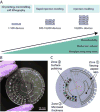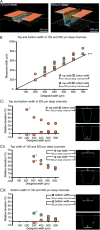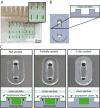Fundamentals of rapid injection molding for microfluidic cell-based assays
- PMID: 29309079
- PMCID: PMC5790604
- DOI: 10.1039/c7lc01052d
Fundamentals of rapid injection molding for microfluidic cell-based assays
Abstract
Microscale cell-based assays have demonstrated unique capabilities in reproducing important cellular behaviors for diagnostics and basic biological research. As these assays move beyond the prototyping stage and into biological and clinical research environments, there is a need to produce microscale culture platforms more rapidly, cost-effectively, and reproducibly. 'Rapid' injection molding is poised to meet this need as it enables some of the benefits of traditional high volume injection molding at a fraction of the cost. However, rapid injection molding has limitations due to the material and methods used for mold fabrication. Here, we characterize advantages and limitations of rapid injection molding for microfluidic device fabrication through measurement of key features for cell culture applications including channel geometry, feature consistency, floor thickness, and surface polishing. We demonstrate phase contrast and fluorescence imaging of cells grown in rapid injection molded devices and provide design recommendations to successfully utilize rapid injection molding methods for microscale cell-based assay development in academic laboratory settings.
Conflict of interest statement
§ The authors acknowledge the following potential conflicts of interest: EB: Tasso, Inc., Salus Discovery, LLC and Stacks to the Future, LLC, DJG: Salus Discovery, LLC and Tasso, Inc., ABT: Stacks to the Future, LLC.
Figures






Similar articles
-
Foil assisted replica molding for fabrication of microfluidic devices and their application in vitro.Lab Chip. 2014 Oct 7;14(19):3695-9. doi: 10.1039/c4lc00659c. Lab Chip. 2014. PMID: 25102283
-
Soft Lithography, Molding, and Micromachining Techniques for Polymer Micro Devices.Methods Mol Biol. 2019;1906:13-54. doi: 10.1007/978-1-4939-8964-5_2. Methods Mol Biol. 2019. PMID: 30488383
-
A facile "liquid-molding" method to fabricate PDMS microdevices with 3-dimensional channel topography.Lab Chip. 2009 May 7;9(9):1200-5. doi: 10.1039/b818721e. Epub 2009 Feb 16. Lab Chip. 2009. PMID: 19370237
-
Macro- and microscale fluid flow systems for endothelial cell biology.Lab Chip. 2010 Jan 21;10(2):143-60. doi: 10.1039/b913390a. Epub 2009 Oct 9. Lab Chip. 2010. PMID: 20066241 Review.
-
Pumps for microfluidic cell culture.Electrophoresis. 2014 Feb;35(2-3):245-57. doi: 10.1002/elps.201300205. Epub 2013 Oct 1. Electrophoresis. 2014. PMID: 23893649 Review.
Cited by
-
Patient-Derived Microphysiological Systems for Precision Medicine.Adv Healthc Mater. 2024 Mar;13(7):e2303161. doi: 10.1002/adhm.202303161. Epub 2023 Dec 10. Adv Healthc Mater. 2024. PMID: 38010253 Free PMC article. Review.
-
Biomedical Applications of Microfluidic Devices: A Review.Biosensors (Basel). 2022 Nov 16;12(11):1023. doi: 10.3390/bios12111023. Biosensors (Basel). 2022. PMID: 36421141 Free PMC article. Review.
-
Biofabrication Strategies and Engineered In Vitro Systems for Vascular Mechanobiology.Adv Healthc Mater. 2020 Apr;9(8):e1901255. doi: 10.1002/adhm.201901255. Epub 2020 Feb 25. Adv Healthc Mater. 2020. PMID: 32100473 Free PMC article. Review.
-
Droplet Incubation and Splitting in Open Microfluidic Channels.Anal Methods. 2019 Sep 21;11(35):4528-4536. doi: 10.1039/c9ay00758j. Epub 2019 Aug 28. Anal Methods. 2019. PMID: 32528558 Free PMC article.
-
A Modular and Cost-Effective Droplet Microfluidic Device for Controlled Emulsion Production.Polymers (Basel). 2024 Mar 11;16(6):765. doi: 10.3390/polym16060765. Polymers (Basel). 2024. PMID: 38543371 Free PMC article.
References
Publication types
MeSH terms
Grants and funding
LinkOut - more resources
Full Text Sources
Other Literature Sources
Research Materials

